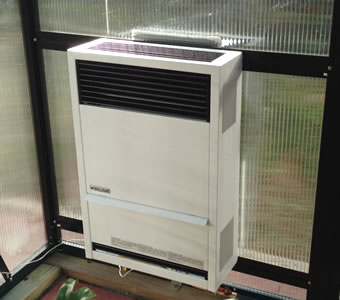We are often asked why we don't sell unvented (often referred to as ventless or vent-free) gas heaters. They are cheap. There is no need to for a vent pipe, They are +99% efficient. They produce byproducts like CO2 which plants need, and add humidity to the greenhouse. What's not to love right? Well let's talk about some misconceptions and the potential dangers of using them in a greenhouse environment.
Unvented Gas Heaters are More Efficient
Not really. The reason they can advertise those +99% efficiencies is because they do not have to include the heat loss from venting the heater byproducts unlike vented heaters which force the byproducts from combustion outside of the greenhouse. Well a greenhouse is considered a confined space by heater manufacturer standards because much more heat is needed per square foot than in an insulated garage or room in a home which is what these heaters were intended for. Why does that matter? Because a ventless heater in a confined space requires both intake and exhaust "openings" in the greenhose for proper heater combustion. Unlike most vented heaters where heat is only escaping through the vent when the heater is running, the holes you made in the greenhouse for the unvented heater are losing heat all of the time making them less efficient than vented gas heaters. What happens if you don't provide these openings? Gas heaters use oxygen for combustion. As the heater runs, it will reduce the oxygen level in the greenhouse. This will cause the heater to starve and not burn as clean which increases byproducts like carbon monoxide and ethylene gas negatively affecting the growth of plants. Eventually the heater will run out of oxygen for combustion and cut off leaving plants in the cold.
Heater Byproducts like CO2 and Water Vapor Benefit Plants
Yes and no. Increases in CO2 and humidity can be beneficial to plants if they are added when the plants need them. The problem is most of the heating in a greenhouse is done at night when plants use the least amount of CO2. Moisture levels in the greenhouse are at a high in the winter especially at night. Adding more water vapor leads to condensation inside the greenhouse and water dripping on plants which leads to disease problems including fungi, blight and molds.
Gas heaters also produce small amounts of sulfur dioxide and ethylene gas which don't have noticeable effects on humans but can be devastating to plants in minute amounts especially to sensitive plants like tomatoes and flowers.

That is why we only sell or recommend vented gas heaters for greenhouses. They do cost more and installation is more involved, but you end up with a much safer and more reliable heat source for your plants. We do not feel the additional risks of using unvented gas heaters in a greenhouse is worth any savings on the initial cost of a heater. If a vented gas heater is out of your budget, an electric heater is a safe low cost alternative for smaller greenhouses.